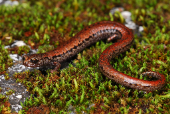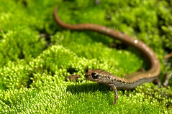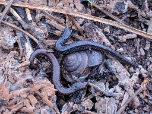Santa Lucia Mountains Slender Salamander (B. luciae)
Description: Adults are 1 1/4 to 1 4/5 inches long from snout to vent. A small slim salamander, with 18 to 19 costal grooves.
Short limbs, a narrow head, long slender body, very long tail, and conspicuous costal and caudal grooves give this species the worm-like appearance typical of most Slender Salamanders. There are four toes on the front and hind feet, which is also typical of Slender Salamanders. (Other California salamanders have five toes on the hind feet.) The ground color is dark blackish-brown overlayed with a brass or reddish dorsal stripe that is less apparent in older animals. The venter is lighter, grayish brown. There is some whitish speckling and metallic iridophores
Habitat: Inhabits moist locations in redwood and mixed evergreen forests. Mostly found on north-facing slopes. Also found in open areas in parks in the city of Monterey.
Range: Endemic to California. Found along the western slope of the northern Santa Lucia Mountains in Monterey county from the Monterey Peninsula south to near the San Luis Obispo county line, and on the eastern slopes from Arroyo Seco south to at least the 36th parallel. The range limits in southern Monterey County are somewhat in question as B. incognitus is being found in new locations in that area and it is possible the two species may not overlap there.
Found in these States:
CA
Diet: Most likely eats small invertebrates. Feeding behavior is not known, but other Batrachoseps species are sit-and-wait predators that use a projectile tongue to catch prey.
Reproduction: Reproduction is terrestrial. Females lay eggs in moist places on land, underground or under surface objects. Captive females from two localities laid average egg clutches of 5.1 and 10.6 eggs. Eggs hatched in an average of 78 days. One probable communal nest has been found containing 19 eggs and several adult salamanders. Young develop completely in the egg and hatch fully formed
Status: Listed as Least Concern since, although its extent of occurrence is less than 5,000 km2, it is common and occurs in an area of extensive, suitable habitat within which the threats are localized, and it has a presumed large population.
»» Kingdom: Animalia - Animals
»» Phylum: Chordata - Chordates
»» Subphylum: Vertebrata - Vertebrates
»» Class: Amphibia - (Amphibians)
»» Order: Caudata - Salamanders
»» Family: Plethodontidae - Lungless Salamanders
»» Genus: Batrachoseps
»» Species: B. luciae - Santa Lucia Mountains Slender Salamander
This article uses material from the Wikipedia article "Santa Lucia Mountains Slender Salamander", which is released under the Creative Commons Attribution-Share-Alike License 3.0. Content may have been omitted from the original, but no content has been changed or extended.
|












